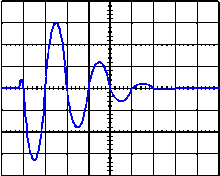PLC-BUS
The PLC-BUS (Powerline Communication Bus - also written as PLCBUS ) is a Powerline -based installation bus in which the switching signals are sent via the existing house installation without the need to lay new lines.
overview
In addition to data lines and radio technology, supply lines themselves can serve as a communication medium, in technical jargon Powerline Communication (power grid communication). The advantages of this transmission path are the high reliability and the low installation effort. The PLC bus system uses bidirectional communication and achieves a reliability of 99.95%. This means max. 5 errors out of 10,000 commands.
PLC-BUS uses the addressing of the X10 protocol and expands the 256 X10 addresses by a factor of 250 to 64,000 addresses. This means that the PLC-BUS is address-compatible with X10 within the room and unit codes and can integrate X10 devices into the house control via a PLC-BUS / X10 coupler . This is of particular interest to users who are already using the X10.
The PLC-BUS system is very similar to the Universal Powerline Bus (UPB) widespread in the Anglo-American region .
history
PLC-BUS was developed by the Dutch company ATS and has been marketed as a technology since 2002. The Chinese company Shanghai Super Smart Electronics adopted the PLC-BUS technology in its home automation products in 2005 and made PLC-BUS one of the leading technologies for home automation in Asia.
Data transfer
The PLC-BUS uses the existing house wiring of the power grid. Two different signals are required for data transmission: the actual data signal and a carrier signal for synchronization. Without a carrier signal, it is not possible to transmit data over long distances. The PLC-BUS uses the AC voltage of the power grid as a carrier signal for its data. The alternating voltage in Germany is based on a sine wave with a voltage of 230 V and a frequency of 50 Hz. A frequency of 50 Hz means that every second 50 full waves with a positive and a negative half-wave are transmitted.
The data signal is modulated onto the 230 V carrier signal with the help of pulse phase modulation . With pulse phase modulation, the data are transmitted by pulses that are modulated onto the carrier signal. The information is coded through a time shift of the pulses and thus different time intervals between the pulses.
According to the PLC-BUS specification, the data pulses are modulated onto the carrier signal within a defined time window in each half-wave, shortly before the carrier signal reaches the zero crossing. The modulation of the pulses at the end of the carrier signal has the advantage that this area is mostly free of other interfering pulses and the sum of the carrier signal and pulse does not exceed 230 V. The time window starts 8.7 ms after the half-wave has passed the zero crossing. The time window is divided into 4 fixed sections of 275 µS each. Each impulse must start and end within one of the 4 sections. Using the pulse position, two bits can be coded and transmitted. During a full wave, consisting of a positive and negative half-wave, 4 bits could be transmitted. Two full waves or 40 ms are required to transmit a complete 8-bit PLC-BUS data byte. With a 230 V power supply with 50 Hz, this results in a data transmission rate of 200 bps.
The position of the pulse within the time window is interpreted by the receiver as either 0, 1, 2 or 3 corresponding to the pulse position Tp0, Tp1, Tp2 and Tp3, which corresponds to a two-bit coding as follows:
| Item | Bit 2 | Bit 1 |
|---|---|---|
| 0 | 0 | 0 |
| 1 | 0 | 1 |
| 2 | 1 | 0 |
| 3 | 1 | 1 |
With this modulation method, only a very low data transmission rate is achieved, but the transmission is very robust and not susceptible to interference. In practice, the signal can be transmitted over very long distances without a filter or amplifier. Compared to the data transmission rates that can be achieved in the local area network , it is very low, but it is completely sufficient for the transmission of control commands.
Communication way
The communication according to the PLC-BUS specification is based on a start byte that is sent before the actual data and prepares the receiver for receiving data. The start byte always has the same structure 2-1-1-2 with regard to the pulse position (Tp2-Tp1-Tp1-Tp2). The definition of a start byte has the advantage that no pulses are modulated onto the power lines during inactivity.
Following the start byte, five bytes of header data are transmitted. These header data contain information such as recipient address, sender address and the data length of the subsequent data. The number of bytes varies according to the information to be transmitted and can be up to 18 bytes. At the end, the transmitted data frame is supplemented by a one-byte checksum in order to be able to determine errors in the transmission.
Thanks to the digital transmission, the PLC-BUS technology represents a secure and highly available bidirectional transmission based on the existing power grid. Actuators can report the receipt and execution of their commands to the controller. A controller has the option of querying the status of an actuator at any time and thus visualizing the conditions in the house.
literature
- Halid Hrasnica, Abdelfatteh Haidine, Ralf Lehnert: Broadband Powerline Communications. Network Design, John Wiley & Sons Ltd, Hoboken 2004, ISBN 0-470-85741-2 .
- Yung C. Shin, Chengying Xu: Intelligent Systems. Modeling - Optimization - and Control, Taylor & Francis Group, Boca Raton 2009, ISBN 978-1-4200-5176-6 .
- Syed R. Rizvi: Microcontroller Programming. An Introduction, Taylor & Francis Group, Boca Raton 2012, ISBN 978-1-4398-5077-0 .
Individual evidence
- ↑ The UPB System Description (PDF; 827 kB)




